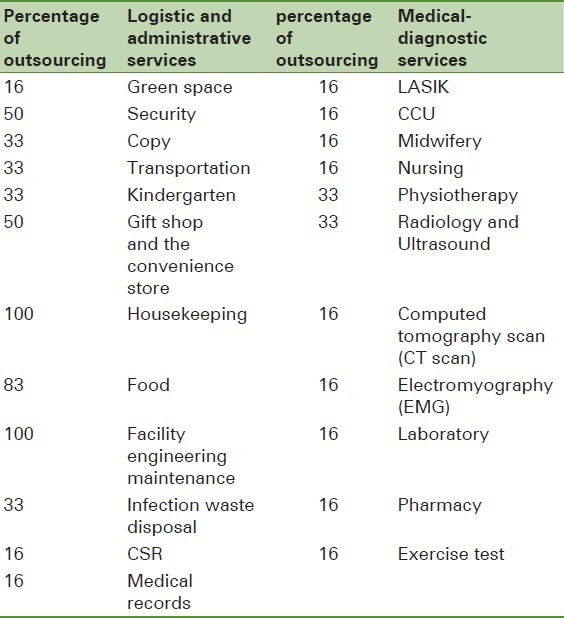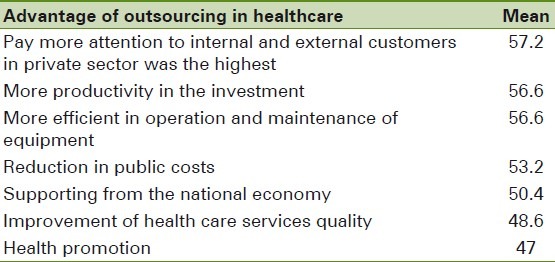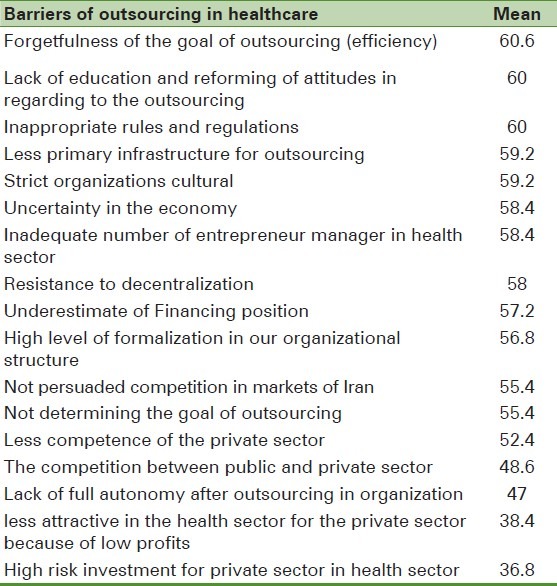Abstract
Purpose:
Outsourcing in healthcare is a cost-effective strategy that can lead to increase services quality. The aim of this study was to determine the types of services that have been outsourced in educational hospitals in Isfahan and to investigate managers’ view about the impact of Outsourcing.
Design/Methodology/Approach:
A descriptive-survey study carried out in 2010. Our samples consisted of 100 educational hospital and treatment deputy senior managers of Isfahan University of Medical Sciences and 53 usable questionnaires were received. Survey instrument main points were the extent to which educational hospital outsource services and the impact of Outsourcing. Reliability and validity of the questionnaire have been verified. Data are analyzed with SPSS18 software.
Findings:
The results for medical-diagnostics services showed physiotherapy, radiology, and ultrasound that have the highest rate (33%) of being outsourced. Between logistic and administrative activities, housekeeping, and facility engineering maintenance services are the highest rate of outsourced (100%) and green space, CSR, laundry, and medical records are the lowest rate of outsourced (16%). In managers’ view, in relation to advantages of outsourcing, pay more attention to internal and external customers in private sector (57.2%) was the highest. In relation to disadvantages of outsourcing, costs increase for the patients (45.6%) was the highest. In relation to barriers of outsourcing, forgetting the goal of outsourcing (efficiency) (60.6%) was the highest.
Conclusion:
Finally, managers’ views about outsourcing in health services organizations were rather acceptable, but in their views, there are barriers in implementation of outsourcing and they are focused on removing the barriers before outsourcing. Fundamental infrastructure developments as making competing market, promoting of cultures, education, modifying the management attitude and approach, and establishing incentive policies are emphasized for successful implementation of outsourcing.
Keywords: Health services, hospitals, Iran, Isfahan, outsourcing
INTRODUCTION
Currently, outsourcing of health services is a hot topic in most countries.[1] Outsourcing is a cost-effective procedure in healthcare[2] that leads to increased service quality levels.[3] Many operations in healthcare have been outsourced during the years. These services include payroll, billing, human resource, marketing, and so on. Other services that have been outsourced in many hospitals include cafeteria, dietary, laundry, and housekeeping. Recently, many of par clinic services as radiology practices have been outsourced.[4] Different types of outsourcing include the following:
Partnership between government and private sectors that public sector still retains the upper hand.
Introducing private sector management to a state-owned enterprise though management services agreement.
The contracting of services to the private sector.[5]
Liu et al.[6] suggested that contracting-out is a political tool with potential of improving access, equity, quality, and efficiency of healthcare.[6] The outsourcing or contracting-out in industrialized countries begun outside the healthcare sector, but it is now a well-developed model for health service providers.[7] Critical reasons of outsourcing are as follows:
Gaining competitive advantage
Access to key technologies
Reducing operational costs
Reducing risk and sharing risk
Access to capital resources
Focus on goals.[8]
The other public hospitals are faced with many problems. Issues like less technical and allocation efficiency, failure in covering low-income and poor groups, and weak accountability to stakeholders are considered as most of public hospital weaknesses performance.[9] According to report of World Health Organization in 1999, public hospital speeded nearly 80% of health system resources, while produced only 20% output.[10] According to these cases, in Iran, based on the executive policy of third development program so far, Ministry of Health is required to outsource 3% of services every year in order to increase effectiveness and efficiency of healthcare.[11] Currently in Iran, the main important healthcare providers are University of Medical Sciences in provinces and the continuums of care include Urban and Rural Health Care Centers and Health House. The private sector is persuaded to initiate establishing offices, clinics, hospitals, and laboratories. Hospitals are almost autonomies in revenue and being autonomy.[12]
Outsourcing in healthcare seems ideal in the theory but there are some difficulties in implementation. However, outsourcing has been seen as a way to decrease the problems in most public organizations. Aksan et al.[13] showed that participation of private sector in health services delivery grew in Turkey in 2001-2006. Hodge[14] estimated that the cost savings has been around 6 to 12% after contracting process with the private sector. Young[15] stated that the benefits of outsourcing include increased staff morale, upgrading capital equipment, and improving services quality. Also, Liu et al.[16] showed that the outsourcing in healthcare increases accessibility to services. Hsiao (2009) showed that most outsourced in non-medical items include medical waste and common trash (94%), gift store (75%), restaurants (56%), security guard (54%), medical instrument maintenance (37%) and in medical items include ambulance (51%), hem dialysis (50), laser (25), laboratory (13), radiology (10%), health examination (10%), nutrition (2%), nurse (2%), and pharmacy (2%). Mayson and Fleshner[17] showed that 74% of Canadian urological believed that private health system reduces wait times and improves accessibility to care (73%). Moschuris and Kondylis[18] showed that outsourcing has led to cost savings, customization, and customer satisfaction. Macinati[19] showed that outsourcing in healthcare would not meet its advantage as cost management and increased utilization review if it be with barriers. Yigit et al.[3] showed that the hospitals have decide to outsource services to decrease the costs (78.8%), increase the quality of services (65.5%), increase flexibility and sharing risk (36.6%), and to increase profits (11.2%). Daniel et al.[4] stated that the benefit of outsourcing referred to reduced costs, improved efficiency, increased quality, increased profits and revenue, produced with lower prices and increased business for global markets. Roberts[20] stated that although outsourcing has several advantages, it is not succeeding if it would not be managed properly. Chief executive officers must have understood the strategies, benefits, risks, and appropriate ways of outsourcing in order to control unnecessary costs and maintain patient care quality.
The aims of the study were to determine the types of services that have been outsourced in educational hospitals in Isfahan and to investigate what advantages, disadvantages, and barriers are in relation to outsourcing in the viewpoints of Isfahan University of Medical Sciences senior managers. At last, solutions for reforming challenges of outsourcing in healthcare are suggested. On the other hand, the results of this study can help policymakers for planning in order to promote current situation of the health system.
RESEARCH METHODOLOGY
To investigate the outsourcing in educational hospital in Isfahan, a survey was conducted in 2010. At first, five experts in Isfahan University of Medical Sciences whose major was Health Service Management were interviewed. A questionnaire was designed based on interviews and literature review. The questionnaire focused on the extent to which educational hospitals outsource services and the advantages, disadvantages, and barriers of outsourcing. To identify which educational hospitals services were outsourced, researchers observed hospital documents and noted them. The questionnaire was developed with five scale (strongly agree, agree, neutral, completely opposed, opposite). Validity of the questionnaire was confirmed in the viewpoints of experts. The reliability was calculated Cronbach's α = 0.800. Then, the questionnaire was distributed among all senior managers of Isfahan University of Medical Sciences (N = 100) which include the senior managers of Treatment Deputy and educational hospitals (Al Zahra Hospital, Noor and Aliasghar Hospital, Eisabne Maryam Hospital, Feyz Hospital, and Imam Mousa Kazem Hospital, Kashani Hospital). A total of 53 usable questionnaires were received, representing a response rate of 53%. The gathered data were analyzed with SPSS18 software.
RESULTS
Table 1 showed the types and rates of outsourced services in educational hospitals in Isfahan. Among the medical-diagnostic services, the services that are most outsourced include physiotherapy, radiology, and ultrasound (33%). Between logistic and administrative activities, housekeeping, facility engineering maintenance servi ces are outsourced by almost all the educational hospitals, and green space, CSR, laundry, and medical records are the least outsourced services (16%).
Table 1.
The rate of outsourced services in educational hospitals in Isfahan-2010

The mean of advantages, disadvantages, and barriers of outsourcing are shown in Table 2–4, respectively. There were seven factors related to the advantages, three to the disadvantages, and 17 to the barriers of outsourcing.
Table 2.
The mean of advantage of outsourcing in healthcare of views of Isfahan University of Medical Sciences Senior Managers -2010

Table 4.
The mean of barriers of outsourcing in healthcare of views of Isfahan University of Medical Sciences Managers -2010

According to what advantages are in relation to outsourcing more respondents indicated that “pay more attention to internal and external customers in private sector,” “More efficiency in operation and maintenance of equipment,” “more productivity in the investment,” and “reduction of public cost,” were the highest benefits concerning outsourcing, respectively.
According to Table 3, “outsourcing affect on increasing the imposed patient costs” was mentioned as the highest disadvantage of outsourcing in healthcare.
Table 3.
The mean of disadvantage of outsourcing in healthcare of views of Isfahan University of Medical Sciences Managers -2010

Table 4 demonstrated the following items that took the highest scores respectively in barriers of outsourcing: “forgetfulness of the goal of outsourcing (efficiency),” “lack of education and reforming of attitudes in regarding to the outsourcing,” “less primary infrastructure for outsourcing,” “strict organizations cultural,” “inappropriate rules and regulations,” “ uncertainty in the economy,” “inadequate number of entrepreneur manager in health sector,” “resistance to decentralization,” “underestimate of Financing position,” “high level of formalization in our organizational structure,” and “not persuaded competition in markets of Iran.”
DISCUSSION
The aim of the study was to investigate the amount of outsourced services in educational hospitals of Isfahan University of Medical Sciences and to survey senior managers’ perceptions about the advantage, disadvantage, and barriers in relation to outsourcing in healthcare.
Research demonstrated that the housekeeping had the most outsourced services in selected hospitals among non-medical services. The finding is similar to the studies of Hsiao et al.[2] and Yigit et al.[3] which found that public services had the most outsourcing in hospitals. In comparison with the results of Hsiao et al.[2] which showed that ambulance unit had the highest percentage and radiology unit had the lowest percentage of outsourcing, our study showed that the radiology was the highest outsourced unit. Also, our study is different in used methods from Hsiao et al.[2] In our study, the administrators of public hospitals were selected as sample while in study of Hsiao et al.,[2] the administrators of a non-profit hospital and a public hospital have been selected.
Research identified some advantages of outsourcing in healthcare, e.g., reduction of public cost, improvement of service quality, internal and external customer satisfaction, increase in efficiency, and promotion of health. Other studies also showed these results. Moschuris and Kondylis[18] have stated that the successful outsourcing led to increase the customer satisfaction and to reduce the costs. However, our study investigated the views of managers of Isfahan university of Medical Sciences, that is a government organization, and its aim was to study the outsourcing in public health care, while Moschuris and Kondylis[18] studied viewpoints of private healthcare organizations and their aim was to investigate the outsourcing in private section of healthcare, which is different in this case from our study.
Our obtained advantages are similar with Yigit et al.[3] and Mayson and Fleshner.[17] Yigit et al.[3] expressed the advantages of outsourcing in Turkish hospitals as cost reduction, improvement of services, participation in risk, and increasing profits. Also, Mayson and Fleshner[17] have noted to affect the outsourcing in quality of healthcare, reduction of waiting times, improved access, health promotion, and patient satisfaction.
Our results showed that the inappropriate laws and regulations are one of the barriers for outsourcing in the health sector. Boardman and Hewitt[21] and Hsiao et al.[2] similarly have referred to obstacle of law and regulation as one of the barriers in outsourcing in the health sector.
CONCLUSIONS AND IMPLICATIONS
This study showed in viewpoints of Isfahan University of Medical Sciences senior managers, a successful implementation of outsourcing can lead to costs reduction, customer satisfaction, and productivity in investment in the healthcare, if be made with the accurate plan. On the other hand, our survey showed that the reason of resistance of public managers was their attitude. Because they believed the main goal of private sector is to increase profit and income and they neglect about other critical dimension. So, the private sector may even lead to impose unnecessary costs on patients.
Although there are several advantages to the outsourcing, there are many barriers to outsourcing in the healthcare. If the fundamental infrastructures of outsourcing, including education, determining the appropriate goal, uses of entrepreneurs’ managers, and so on are not reformed, the main goal of outsourcing in the health sector (cost reduction, increasing quality, efficiency, and effectiveness) is not achieved.
On the other hand, it seems necessary to reform the laws and regulations and to design an appropriate model according to health system structure. Policymakers should focus on developing the education programs, modifying the management attitude and approach and apply incentive policies for moving toward outsourcing in healthcare.
Footnotes
Source of Support: Nil
Conflict of Interest: None declared
REFERENCES
- 1.Tit A. Privatization processes in health care in Europe-a move in the right direction, a trendy option, or a step back. Eur J Public Health. 2009;19:448–51. doi: 10.1093/eurpub/ckp146. [DOI] [PubMed] [Google Scholar]
- 2.Hsiao CT, Pai JY, Chiu H. The study on the outsourcing of Taiwan's hospitals: A questionnaire survey research. BMC Health Serv Res. 2009;9:78. doi: 10.1186/1472-6963-9-78. [DOI] [PMC free article] [PubMed] [Google Scholar]
- 3.Yigit V, Tengilimoglu D, Kisa A, Zeedan YM. Outsourcing and Its Implications for Hospital Organizations in Turkey. J Health Care Finance. 2007;33:86. [PubMed] [Google Scholar]
- 4.Daniel J, Altman MD, Richard B, Gunderman Outsourcing: A Primer for Radiologists. J Am Coll Radiol. 2008;5:893–9. doi: 10.1016/j.jacr.2008.03.005. [DOI] [PubMed] [Google Scholar]
- 5.Elhussein Mansour A. The Impact of privatization on the United Arab Emirates federal public sector. Int Public Manage Rev. 2008;9:66–89. [Google Scholar]
- 6.Liu X, Hotchkiss DR, Bose S, Bitran R, Giedion U. Contracting for primary health services: Evidence on its effects and a framework for evaluation. Partners Health Reform Plus. 2004:1–56. [Google Scholar]
- 7.Laamanen R, simonsen-Rehn N, Suominen S, Qvertveit J, Brommels M. Outsourcing primary health care services-how politicians explain the grounds for their decisions. Health Policy. 2008;88:249–307. doi: 10.1016/j.healthpol.2008.04.001. [DOI] [PubMed] [Google Scholar]
- 8.Chen T. A Symmetric strategic alliance: A network view. J Bus Res. 2002;55:1007–13. [Google Scholar]
- 9.Preker AS, Harding A. Washington, D.C., U.S: World Bank Publication; 2003. Innovation in health service delivery: The Corporatization of public hospitals. [Google Scholar]
- 10.Geneva: WHO; 1999. WHO. Health centers: The 80/20 Imbalance- Burden of Work vs. Resources. [Google Scholar]
- 11.Abdi M, Shabestari I. Tabriz, Iran: 2008. Outsourcing and its impact on hospital administration”, the fifth conference of the health services management 2008, May 19-22. [Google Scholar]
- 12.Byramy Jabbari H, Tabibi J, Delgoshaei B, Mahmoudi M, Bakhsian F. Comparative study of mechanisms of decentralization in health services in different countries and designing a model for Iran. Health Manage. 2008;10:33–40. [Google Scholar]
- 13.Aksan HA, Ergin I, Ocek Z. The change in capacity and service delivery at public and private hospitals in Turkey: A closer look at regional differences. BMC Health Serv Res. 2010;10:300. doi: 10.1186/1472-6963-10-300. [DOI] [PMC free article] [PubMed] [Google Scholar]
- 14.Hodge GA. Boulder, CO: West view Press; 2000. Privatization an international review of performance. [Google Scholar]
- 15.Young SH. Outsourcing and benchmarking in a rural public hospital: Does economic theory provide the complete answer?”. Rural Rem Health. 2003;3:124–37. [PubMed] [Google Scholar]
- 16.Liu X, Hotchkiss DR, Bose S. The effectiveness of contracting out primary health care services in developing countries: A review of the evidence. Health Policy Plann. 2008:231–13. doi: 10.1093/heapol/czm042. [DOI] [PubMed] [Google Scholar]
- 17.Mayson B, Fleshner N. Physician opinion of the privatization of health care services in Canada: A survey of Canadian urologists by the Canadian Urological Association Socioeconomic Committee. Health Policy Rep. 2009;3:193–7. doi: 10.5489/cuaj.1070. [DOI] [PMC free article] [PubMed] [Google Scholar]
- 18.Moschuris SJ, Kondylis MN. Outsourcing in private healthcare organizations: A Greek perspective. Health Organ Manage. 2007;21:220–3. doi: 10.1108/14777260710736895. [DOI] [PubMed] [Google Scholar]
- 19.Macinati MS. Outsourcing in the Italian National Health Service: Findings from a national survey. Health Plan Manage. 2008;23:21–36. doi: 10.1002/hpm.902. [DOI] [PubMed] [Google Scholar]
- 20.Roberts V. Managing strategic outsourcing in the healthcare industry. J Healthc Manage. 2001;46:239–49. [PubMed] [Google Scholar]
- 21.Boardman AE, Hewitt ES. Problems with contracting out government services: Lessons from orderly services at SCGH. Ind Corp Change. 2004;13:917–29. [Google Scholar]


